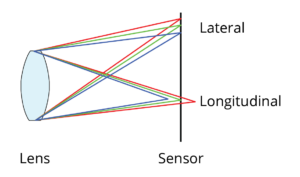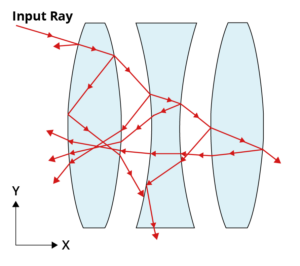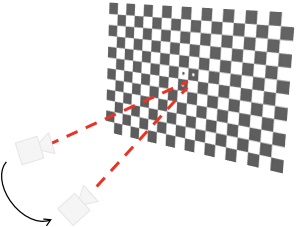The quality of a camera lens determines how an image forms on a sensor. Lens quality is tested to verify the lens is designed, built, and focused correctly. Once a highly tedious process, Imatest has since refined the testing practice with several solutions, including highly accurate and specific test charts and fixtures.
Geometric Calibration – Relevant Standards – Supply Chain Image Quality
Testing Distance
To determine what size of test chart is needed, use the Imatest Chart Finder that can also calculate the imaging plane based on the sensor pixel dimensions, lens field of view (FOV), and working distance. For small working distances (such as medical microscopes and endoscopes), high-precision film and chrome on glass charts are used to perform tests. For long working distances, larger Imatest charts are necessary or collimators can be used to simulate extended distances when testing in a limited space. Imatest SFRplus, eSFR ISO, and Checkerboard chart can produce lens results that are clear and straightforward. These options include the measurement, evaluation, and testing of several image-quality factors, including sharpness, lens flare, geometric calibration, and chromatic aberration.
Chromatic Aberration
Chromatic aberration (CA) is one of several aberrations that degrade lens performance and includes coma, astigmatism, spherical aberration, and curvature of field. CA occurs because the glass refractive index can vary from the wavelength of light bending colors by different amounts. Minimizing chromatic aberration is one of the traditional goals of lens design and is accomplished by combining glass elements with different dispersion properties. Yet, chromatic aberration remains a problem in several lens types, most notably ultrawide lenses, long telephoto lenses, and extreme zooms.
- Know how to measure and correct for chromatic aberration.
- Learn how to use SFRplus, Checkerboard and Dot Pattern charts.
Lens Flare
Lens Flare (also known as veiling glare and image fog) is stray light that degrades image quality in or near the field of view. It can be controlled by careful lens design that includes high-quality lens coatings (multilayer coatings are best) and baffling in the lens barrel, using a lens hood or any object in the field to shield the lens from the sun, and modifying light sources in the studio with the use of a “barn door.” Imatest solutions measure for lens flare using ISO 18844.
- Understand how to measure the impact of flare light on dynamic range.
- Avoid reflections on transmissive charts for dynamic range and flare testing.
- Understand the ISO18844 standard in controlling lens flare.
- Read Veiling Glare AKA Lens Flare.
Geometric Calibration
Lenses bend and project light from 3-dimensional objects onto 2-dimensional arrays. This process commonly introduces distortions, where distances and geometry in an image will be distorted geometrically from how they exist in space. Characterizing geometric distortion is important for understanding lens performance.
- Understand lens distortion.
- Read through the requirements to understand what evidence the geometric calibrator needs and how to design a test setup accordingly.
- Consult the Imatest terminology pages to clarify the many details of calibration (units and coordinate systems).
- Learn how Imatest defines the components of calibration tasks.
- Decide on a supported target configuration based on device parameters and the space allotted by a test setup.
- Familiarize yourself with the software operation (Imatest Master’s GUI or Imatest IT’s programmatic interface).
Relevant Standards
- ISO 12233 Resolution—This standard defines three test charts. The Imatest eSFR ISO module performs a highly automated analysis of the new low contrast (4:1) Edge SFR chart and is available in Imatest Master.
- ISO 15739 Noise Measurements—This standard is the dynamic range calculation for measuring signal-to-noise ratio and visual noise.
- ISO 18844 Flare—This standard is used for measuring the amount of image flare in digital camera systems.
- IEEE P1858 CPIQ Camera Phone Image Quality—This standard seeks to correlate objective test results with human perception. The most lens-dependent metrics include edge and texture acutance, lateral geometric distortion (LGD) and lateral chromatic displacement (LCD).
Managing Supply Chain Image Quality
The process of balancing manufacturing outcomes with product design requirements are complicated by the need to correlate results with partner tests. At Imatest, we help device manufacturers to achieve an optimal balance between quality and yield by offering a rigorous manufacturing quality control regime. This method establishes reasonable thresholds of acceptability for each manufacturing step, helps minimize sources of measurement variation, validates testing equipment, and employs a failure analysis to identify strategic problems.
Talk to our engineers about how we can help you test your lenses.





